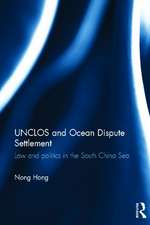The Making of the Test Ban Treaty
Autor Ronald J. Tercheken Limba Engleză Paperback –
Preț: 384.31 lei
Nou
Puncte Express: 576
Preț estimativ în valută:
73.54€ • 76.97$ • 61.21£
73.54€ • 76.97$ • 61.21£
Carte tipărită la comandă
Livrare economică 01-15 aprilie
Preluare comenzi: 021 569.72.76
Specificații
ISBN-13: 9789401186896
ISBN-10: 9401186898
Pagini: 228
Ilustrații: XIV, 211 p. 1 illus.
Dimensiuni: 155 x 235 x 12 mm
Greutate: 0.33 kg
Ediția:1970
Editura: SPRINGER NETHERLANDS
Colecția Springer
Locul publicării:Dordrecht, Netherlands
ISBN-10: 9401186898
Pagini: 228
Ilustrații: XIV, 211 p. 1 illus.
Dimensiuni: 155 x 235 x 12 mm
Greutate: 0.33 kg
Ediția:1970
Editura: SPRINGER NETHERLANDS
Colecția Springer
Locul publicării:Dordrecht, Netherlands
Public țintă
ResearchCuprins
I. Introduction.- II. The President and the Treaty.- The President: Goals and Constraints.- Accumulated Experiences.- Presidential Formulation of Policy.- Preliminary to Success: The American University Speech.- The Harriman Mission.- The President and the Treaty.- Linkage with Domestic Constituencies.- Linkage with Foreign Constituencies.- Conclusions.- III. Decision-Making in the Executive Branch.- The Committee of Principals.- The Arms Control and Disarmament Agency.- The Department of State.- The Atomic Energy Commission.- The Department of Defense.- Conclusions.- IV. The Media and the Treaty.- The Communication Role of the Press.- The Barometer Role of the Press.- The Decoding Role of the Press.- Magazines.- Radio and Television.- Uses of the Press by Decision-Makers.- Summary.- V. Group Articulation and Activity.- Primary and Secondary Goals.- The Activity and Position of the Peace Groups and Their Allies.- The Religious Groups.- The Economic Groups.- Veterans’ Organizations.- Opposition and Patriotic Groups.- The Experts.- The Active Groups.- VI. Public Opinion and the Test Ban Treaty.- Inputs and Responses.- Public Opinion and the Test Ban Treaty.- The Structure of Opinion on Nuclear Testing.- Interest and Apathy.- VII. The Senate: Preliminary Considerations.- Initial Senatorial Reaction.- Executive-Legislative Relations.- The Committee on Foreign Relations.- The Preparedness Investigating Subcommittee.- VIII. The Senate: The Debate and Vote.- The Senate and Public Opinion.- The Senate Debate.- Three Senatorial Approaches to Arms Control.- The Administration and the Senate.- The Senate Vote.- Conclusions.- IX. Conclusions.- Public Opinion and Foreign Policy: Burke Revisited.- Option Management.- Feedback: The Options of the Opposition.- Summary andConclusions.- Appendix I.- Comparison Between Texts of Treaty Tabled at the Geneva Disarmament Conference on August 27, 1962, and that Signed at Moscow on August 5, 1963.- Appendix II.- Selected Senate Roll Call Votes.















